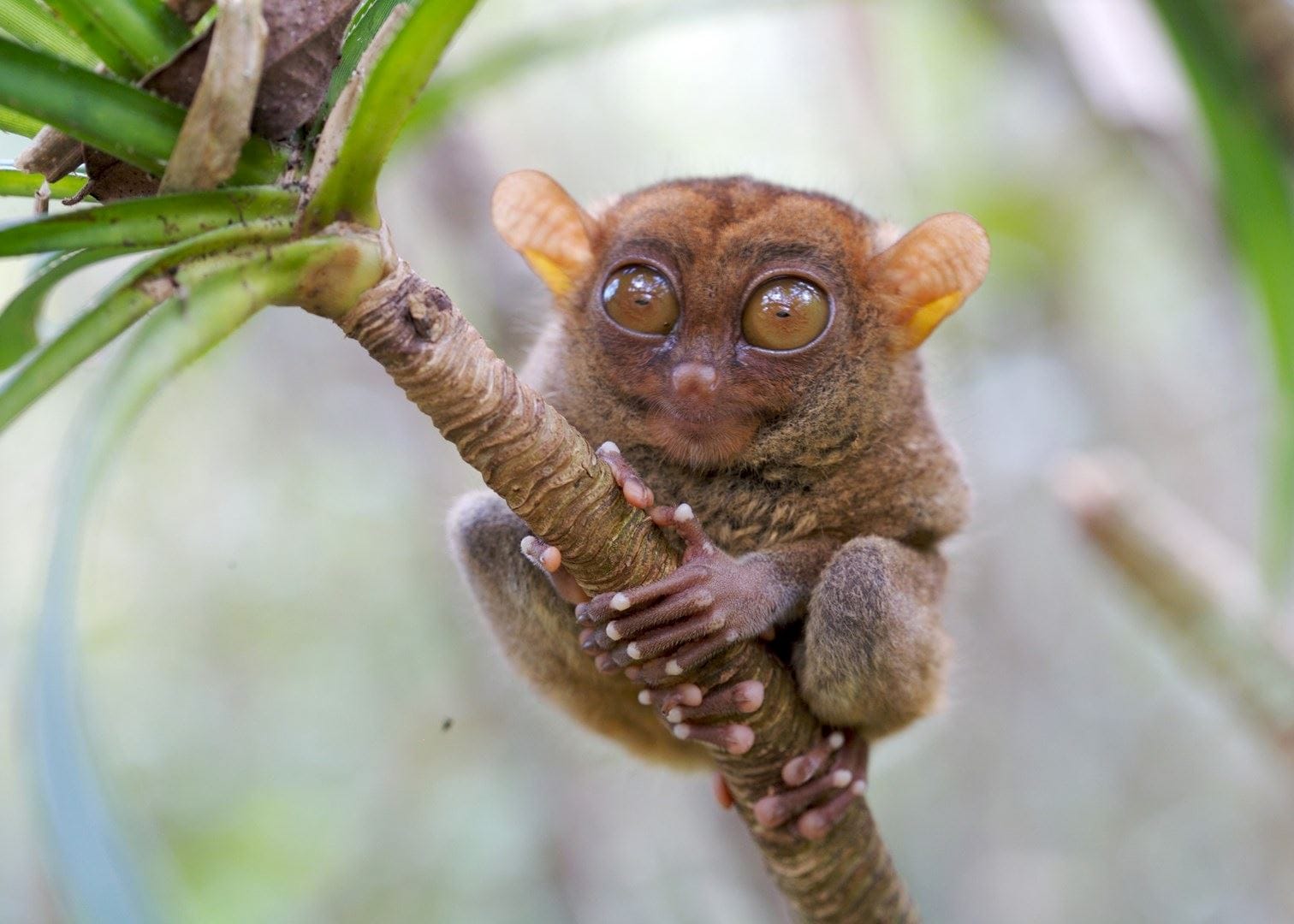Get ready to meet the Philippine tarsier, a tiny, nocturnal primate with big eyes and a love for the night. Known locally as “mawmag” or “magô,” this elusive creature is a vital part of the Southeast Asian ecosystem. Join us on an adventure into the tarsier’s world, where we’ll explore its unique features, fascinating behaviors, and the challenges it faces in the modern world. Hold on tight as we dive into the shadows and uncover the secrets of the Philippine tarsier, a guardian of the ancient forests that have been its home for centuries.
Tiny Guardians: A Closer Look at the Philippine Tarsier
Deep in the heart of the Philippine forests, hidden amongst the trees, lives an animal as fascinating as it is rare: the Philippine tarsier. Imagine an animal smaller than your hand, with eyes bigger than its stomach – that’s our little friend, the tarsier! These incredible creatures, some of the smallest primates on Earth, are a true testament to the wonders of evolution.
Their enormous eyes are a crucial adaptation for their nocturnal lifestyle, giving them incredible night vision in the near-total darkness of their forest habitat. But that’s not all. Imagine being able to turn your head almost all the way around – yep, tarsiers can do that! This incredible ability gives them a panoramic view of their surroundings, helping them spot tasty insects and small animals.
Speaking of dinner, these little guys are surprisingly athletic. Their powerful legs allow them to jump up to six times their body length – that’s like a human jumping over a car! They use these amazing leaps to snatch insects mid-air or move swiftly through the trees. And speaking of trees, have you ever wished you could climb like a pro? Well, the tarsier puts any human climber to shame. Their fingers and toes have specialized pads that act like suction cups, allowing them to cling to branches and bamboo with ease.
Sadly, our tiny nocturnal friends are facing some big challenges. Deforestation, which is the clearing of forests for other uses, is shrinking their home at an alarming rate. And if that wasn’t bad enough, some people illegally capture tarsiers to sell as pets, which is extremely harmful to these delicate creatures.
The future may seem uncertain for these little primates, but there’s hope yet. Organizations like the Philippine Tarsier Foundation are working hard to protect these remarkable creatures. They’re working to conserve tarsier habitat, educate people about the importance of protecting them, and rescue tarsiers from the illegal pet trade.
The Philippine tarsier, with its big eyes, even bigger jumps, and crucial role in the forest ecosystem, reminds us that even the smallest among us can have a huge impact. By learning about and protecting these fascinating creatures, we’re not only safeguarding a piece of the Philippines’ natural heritage, but we’re also contributing to a healthier planet for all.
Is the Philippine Tarsier a Monkey? Unveiling the Truth About This Tiny Primate
We’ve all heard it – that the Philippine tarsier is the “world’s smallest monkey.” It’s a cute idea, this tiny creature being a miniature version of those playful primates swinging through trees. But here’s the thing: it’s not actually true! Tarsiers might share some similarities with monkeys at first glance, but dig a little deeper and you’ll find they’re a totally different kind of awesome.
Think of it like this: you have cousins, right? You’re related, you might even look a bit alike, but you’re each your own person with unique traits. It’s kinda the same with tarsiers and monkeys. They’re distantly related in the grand scheme of the primate family tree, but their evolutionary journey has taken them down different branches, leading to some very distinct differences.
One of the biggest giveaways is in their ankles – seriously! Tarsiers have these super long ankle bones, called tarsi (hence their name!), which give them incredible jumping power. We’re talking leaps of over 10 feet! Monkeys, on the other hand, are more about climbing and swinging, so their ankles aren’t built the same way.
Then there are the eyes. Tarsier eyes are HUGE compared to their tiny bodies, even bigger than their brains! This is because they’re nocturnal hunters, relying on their incredible night vision to catch insects. Monkeys, being mostly active during the day, don’t need such powerful peepers.
And if you thought that was cool, get this: tarsiers can rotate their heads almost 360 degrees, like little owls! This helps them stalk prey and keep an eye out for danger in their forest homes. Monkeys can turn their heads pretty far too, but nothing quite like that!
Scientists use all these differences, along with studying their DNA and fossils, to classify animals. So, while both are primates, monkeys belong to groups like the Cebidae family (think squirrel monkeys) or the Cercopithecidae family (like baboons), while tarsiers have their own exclusive club – the Tarsiidae family.
The more we learn about the Philippine tarsier, the more we realize just how special and unique it is. It’s a testament to the incredible diversity of life on Earth, and a reminder that there’s still so much more to discover about the natural world!
Understanding the Plight of the Philippine Tarsier: Why are they Endangered?
We’ve already talked about how special and unique Philippine tarsiers are, but sadly, their future is far from certain. These tiny primates are facing some big problems that are putting their very existence in jeopardy. Let’s take a closer look at what’s driving these adorable creatures towards the brink of extinction.
Habitat Loss: Squeezing Out the Tarsiers
Imagine your home slowly shrinking, with less and less space for you to live. That’s the reality for Philippine tarsiers as their forest homes are chopped down for timber and dug up for minerals. Logging and mining operations are rapidly destroying the very places where tarsiers find food, shelter, and raise their young.
What’s worse is that the remaining forest patches are often small and isolated, making it difficult for tarsiers to move around and find mates. This fragmentation of their habitat weakens the overall population and makes them more susceptible to other threats.
Illegal Pet Trade: Caged for Curiosity
The very same features that make tarsiers so fascinating—their large, expressive eyes and gentle demeanor—have also made them a sought-after commodity in the illegal pet trade. Greedy individuals capture these delicate animals from the wild and sell them into a life of confinement, often under cruel and inhumane conditions. This illegal trade not only removes tarsiers from their natural environment but also inflicts immense stress and suffering upon these sensitive creatures.
Irresponsible Tourism: Loving Them to Death?
While tourism can be a powerful tool for conservation when done responsibly, unregulated tourist interactions with tarsiers can do more harm than good. Imagine being constantly bombarded by flashing lights and loud noises—that’s the stressful reality for tarsiers when tourists get too close or disregard ethical guidelines. Additionally, handling tarsiers, even with the best intentions, can disrupt their natural behaviors and transmit diseases, further jeopardizing their well-being.
Knowledge Gaps: The Mystery of the Missing Data
To effectively protect any endangered species, scientists and conservationists need reliable information about their population numbers, distribution, and the specific threats they face. Unfortunately, when it comes to Philippine tarsiers, there are still significant gaps in our understanding. This lack of comprehensive data makes it challenging to develop targeted conservation strategies and measure their effectiveness. For example, did you know that while the Pinta Island Tortoise is critically endangered with only one known survivor, the lack of data on the Philippine Tarsier makes it difficult to determine exact population numbers.
The Path Forward: A Glimmer of Hope
The situation might seem dire, but it’s not hopeless. Increased awareness about the plight of Philippine tarsiers, combined with stricter enforcement against illegal activities and responsible tourism initiatives, can help turn the tide. Ongoing research is crucial to filling in the knowledge gaps and guiding conservation efforts. By understanding the complex challenges facing these tiny primates, we can work towards ensuring their survival for generations to come.
Unlocking the Secrets of Tarsiers: Why These Adorable Primates Don’t Belong in Your Living Room
We’ve already established that tarsiers are pretty amazing little creatures, right? With their giant eyes and incredible jumping abilities, it’s no wonder some people might think about having one as a pet. But here’s the thing—keeping a tarsier as a pet is actually really bad for them, and we’ll talk about why.
Imagine being taken from your home and everything you know, then thrown into a totally strange environment. That’s what it’s like for a tarsier taken from the wild to be a pet. These tiny primates are incredibly sensitive to stress. Loud noises, bright lights, and even just being around humans can freak them out. This stress can get so bad that they might start hurting themselves or, sadly, even die. Even captivating marine creatures like the pink meanie jellyfish belong in the ocean, not in captivity.
Now, let’s talk about their diet. Tarsiers are like picky eaters of the primate world. They mainly eat live insects—specific kinds, too, not just any bug will do! Trying to copy this diet in a home setting is tough. You can’t just give them store-bought crickets; they need fresh insects that are good for them.
On top of that, tarsiers need a lot of space to move around, and their living space needs to be kept at a certain temperature and humidity, just like their natural habitat. They’re also social animals used to living in small family groups, so being alone is tough on them.
When people try to keep tarsiers as pets, it often fuels something called the illegal pet trade. This means people go out into the wild and capture tarsiers to sell them, which really messes with wild tarsier populations. Plus, their forest homes get destroyed to make way for humans, which is a huge problem for the Philippine tarsier, which is already endangered.
So, what can we do instead of trying to make them pets? Supporting reputable tarsier sanctuaries is a great way to help. These sanctuaries make the well-being and conservation of tarsiers their top priority. If you want to see these amazing creatures in person, look into responsible ecotourism. This way, you can observe them in their natural habitat without causing them any harm. By spreading the word about the challenges tarsiers face, you can help protect these fascinating and vulnerable animals.
Key Points:
- The Philippine tarsier is a tiny primate with enormous eyes, making it one of the smallest primates on Earth.
- Tarsiers are nocturnal animals with excellent night vision and the ability to rotate their heads almost 360 degrees.
- They have powerful legs that allow them to jump up to six times their body length, enabling them to catch insects and climb trees with ease.
- Tarsiers are facing threats from deforestation and illegal pet trade.
- Organizations like the Philippine Tarsier Foundation are working to conserve tarsier habitat, educate the public, and rescue tarsiers from the pet trade.
- Tarsiers play a crucial role in the forest ecosystem, highlighting the significance of even the smallest species.
- Protecting tarsiers and their habitat contributes to a healthier planet for all.
- Unlock Water’s Symbolism: A Cross-Cultural Exploration - April 20, 2025
- Identify Black and White Snakes: Venomous or Harmless? - April 20, 2025
- Unlocking Potential: Origins High School’s NYC Story - April 20, 2025
















2 thoughts on “Unveiling the Enigmatic Philippine Tarsier: Guardians of Ancient Philippine Forests”
Comments are closed.